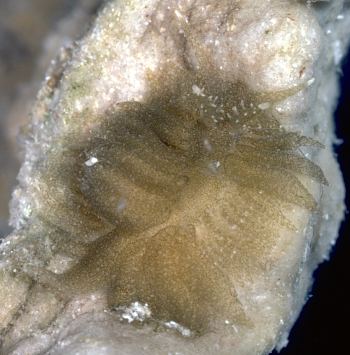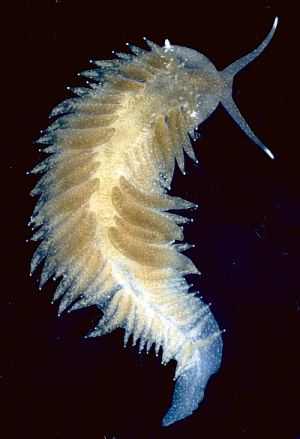

Aeolidiopsis harrietae
Rudman, 1982
Order: NUDIBRANCHIA
Suborder: AEOLIDINA
Family: Aeolidiidae
DISTRIBUTION
Known at present from the southwestern Pacific [Great Barrier Reef, New Caledonia].
PHOTO
40mm long, Heron Is, Cent Qld, on Palythoa sp. June, 1983. AM C138598. Photos: Bill Rudman
The animal broad and elongate, with a wide foot, rounded at the anterior end. It can grow to 40mm in length. The oral tentacles are relatively small with bluntly rounded tips. The rhinophores are short and rounded, and bear a few long papillae. The cerata are dorsoventrally flattened, broadly rounded along the anterior edge and with an angle about midway along the posterior edge. They are relatively large and lie out from the body, either held horizontally, or sometimes following the contour of the side of the body before extending out horizontally. The cerata are arranged in almost horizontal rows with a slight anterior downwards slope. They are arranged so that only the anterior edge of each ceras is shaded by the ceras in front. There is only one ceratal row anterior to the pericardium.
The whole animal appears a brownish straw colour from internal body fluids. All the dorsum has a network of fine red-brown specks, rather irregularly arranged on the head, but forming a transverse pattern on the dorsum behind the rhinophores. The dorsal side of the oral tentacles has similar markings and so do the rhinophores, except for the tip and the ends of the papillae, which are yellowish white. The anterior end of the foot and the posterior end of the foot also have this brown network. The part of the foot that lies beneath the cerata is straw coloured with white specks. The sides of the body beneath the cerata are straw coloured with only a very few patches of brown. The dorsal surface of the cerata is covered with a brown reticulate pattern but the edges and the ventral surface are not. There is a white tip to each ceras and white patches on the upper third of the dorsal side. There is also a distinctive white knob halfway along the posterior edge of each ceras. The sole of the foot is straw coloured.
The digestive gland branches in all the cerata, and as well as small tubules on the dorsal body wall there are many large tubules in the dorsal body cavity. The cells of the digestive gland contain many zooxanthellae, especially near the dorsal surface of the body and the posterior edge and upper third of each ceras. It is the zooxnathellae that give the animal its brown colouration. The cnidosac is relatively large.
When crawling on the colonial zoantharian Palythoa, the animal is extremely difficult to see. As with Aeolidiopsis ransoni, the cerata are held either horizontally or lower, sometimes following the contour of the side of the body then lying out horizontally just above the foot. The morphological peculiarities, such as reduced number of flattened cerata arranged in almost horizontal rows and complex ramifications of the digestive gland throughout the body wall, suggest a symbiotic relationship with zooxanthellae obtained from Palythoa. Aeolidiopsis harrietae can be distinguished from A. ransoni by its papillate rhinophores, position of the anus below the ceratal rows, and shape of the radular teeth.
See:
• A. ransoni - Biology and natural history.
• A. ransoni.
• Solar-powered Opisthobranchs
• Feeding on Palythoa
Reference:
• Rudman, W.B. (1982) The taxonomy and biology of further aeolidacean and arminacean nudibranch molluscs with symbiotic zooxanthellae. Zoological Journal of the Linnean Society, 74: 147-196.
Rudman, W.B., 2002 (July 18) Aeolidiopsis harrietae Rudman, 1982. [In] Sea Slug Forum. Australian Museum, Sydney. Available from http://www.seaslugforum.net/factsheet/aeolharr
Related messages
-
Re: Aeolidiopsis harrietae sp. from Kasheli, Ratnagiri
From: Vishal Bhave, November 17, 2009 -
Aeolidiopsis harrietae from New Caledonia
From: Bill Rudman, July 24, 2002 -
Is Aeolidiopsis a good genus?
From: Bill Rudman, July 24, 2002 -
Aeolidiopsis harrietae from GBR
From: Bill Rudman, July 24, 2002
